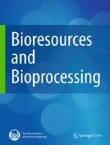Bioresources and Bioprocessing is associated with the State Key Laboratory of Bioreactor Engineering, East China University of Science and Technology.
Non-targeted discovery of high-value bio-products in Nicotiana glauca L: a potential renewable plant feedstock
The evaluation of plant-based feedstocks is an important aspect of biorefining. Nicotiana glauca is a solanaceous, non-food crop that produces large amounts of biomass and is well adapted to grow in suboptimal co...












































